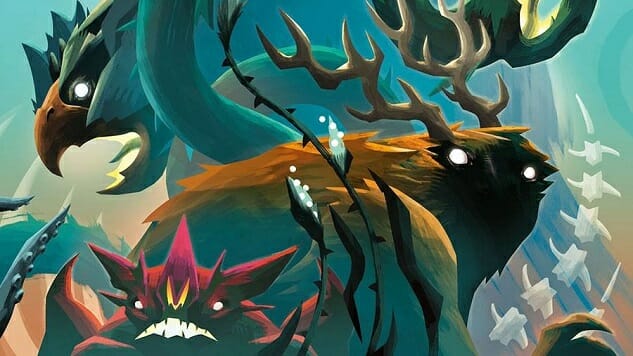
One of my top ten games of 2018, Cryptid looks like a regular area-control or worker-placement board game. It’s actually a deduction game that distills a single mystery—on which hex is the mysterious Creature located—down to a fixed number of clues matching the number of players. If you combine all of the players’ clues together, only one space could still be the answer to the puzzle, and you win the game by being the first to use a turn to correctly identify that space. Of course, solving the puzzle is part of the fun, but you have to try to keep other players from deducing your clue as you try to guess theirs, and that misdirection is almost as fun as winning the whole thing.
The Cryptid board is variable, and you can use cards that come with the game or the game’s site at ospreypublishing.com/playcryptid to get the setup and clues for a specific puzzle. The board has X hex spaces on it, with five terrain types and multiple bear or cougar territories, and six fixed structures to start the game (eight if you play the advanced mode), two each in green, white, and blue. Each player then gets a clue about the Creature’s location that specifies that the Creature is N spaces from something. For example, the Creature could be within three spaces of a green structure, or within two spaces of a cougar territory. The clue could also say the Creature is on a forest or desert space, or say it’s within one space of an animal territory of either type.
On your turn, you get to ask one opponent a single question: According to your clue, could the Creature be here, where you place the black pawn on any space on the board. The responding player must answer truthfully, placing a round disc on the space if their clue means the Creature could be there and a cube if the clue precludes it. If the latter is true and the other player says “no,” then you must also place one of your cubes on a space where the Creature could not be, according to your clue. Players go around the table, asking questions, and the board will gradually fill up with yes and no tokens.
Eventually, someone might have enough evidence to try to deduce all of the other clues and guess the Creature’s location, so instead of posing a question to one player, you would then pick a spot, place one of your own discs (for yes) on that space, and go around the table, asking each other player if the Creature could be on that space according to their clues. The other players answer, placing discs on the space for yes, until someone says no and places a cube on that space, ending the first player’s turn. If all players answer yes, then, assuming everyone understood their clues correctly, that should be the answer to the game; the player checks the answer sheet or the website to see if they have won.
There’s some luck involved in Cryptid, because you might simply ask players suboptimal questions that don’t help you narrow down their clues, but since all information is public there isn’t any real disadvantage here from random chance. It’s also a truly independent deduction game, unlike the classic Scotland Yard, where one player was the fugitive Mr. X and everyone else teamed up to find him; and it doesn’t have the elimination element of some of the best deduction games on the market like Coup. Cryptid takes a little bit from other deduction games and then asks players to, in essence, solve a logic problem in their heads (although pen and paper are allowed if you need them) to figure out something that no player knows. It reminded me in that respect of Orient Express, a murder mystery game from the 1980s that used logic grids as the core mechanic, where players would move around the board, gathering clues to fill out their individual grids. Cryptid has the same feel, but it’s streamlined, faster, and much more interactive.
Cryptid plays three to five players, although there’s a two-player variant where the players set up a four-player game and then each starts with two clues, using two sets of colored cubes and discs apiece. Games take under a half an hour as long as everyone reads their clues correctly (and yes, I’m absolutely subtweeting someone here). The official age range is 10+, although the real lower bound depends on the child—I was getting GAMES magazine by that age and doing logic puzzles, so if your kid is also into puzzles, you might find Cryptid a perfect fit for family play. Even for adults, it’s a nice balance between a true party game that gamers might not love and a Eurogame that might turn off folks who hear that and picture Ben Wyatt talking about cones.
Keith Law is a senior baseball writer for ESPN.com and an analyst on ESPN’s Baseball Tonight. You can read his baseball content at search.espn.go.com/keith-law and his personal blog the dish, covering games, literature, and more, at meadowparty.com/blog.